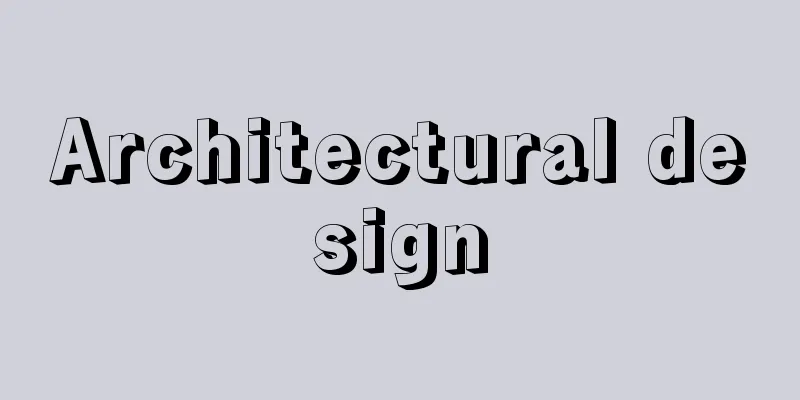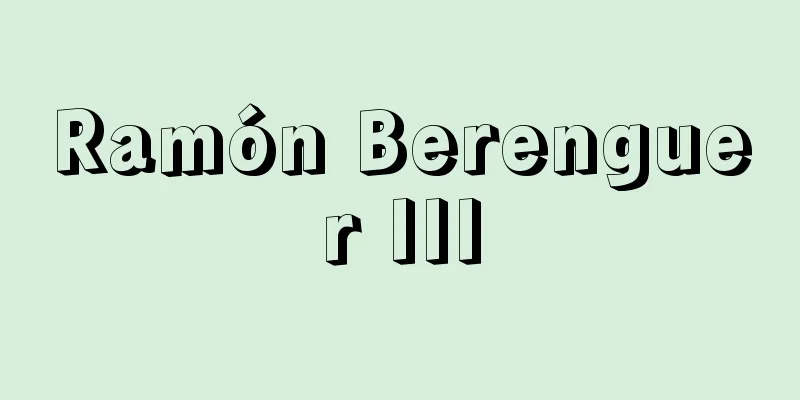Architectural design

|
Design is the act of planning the structure, materials, construction costs, etc., in accordance with the intention of constructing a building, and clearly indicating them through drawings or other means. More generally, design is the act of planning something, not limited to architecture, and thinking up the procedures for realizing it. [Toshihiko Ota] Design ClassificationArchitectural design includes various contents and is expressed in various ways depending on the viewpoint, but it can usually be classified by (1) object, (2) stage, (3) method, or (4) construction method. That is, (1) is a classification that simply clarifies the object of design by building type or use, such as office design or school design, and further includes structural design and equipment design for a certain function of the building, as well as acoustic design and lighting design for a certain performance of the architectural space. (2) is generally divided into basic design and implementation design according to the architectural production process, and further includes terms such as outline design (esquisse in French), rough design (sketch design), and detailed design (detail) according to the development of the design phase. (3) is related to the design method, and includes competitive design and special design to decide the designer, and joint design in which multiple designers work together as a design process. In addition, design that standardizes or standardizes a certain procedure is called standard design or standard design. Recently, automatic design using computers has also been put to practical use, and is called computer-aided design, commonly known as CAD. (4) refers to designs that can be classified according to their correspondence with construction methods, whereas the previous section is a change in the design method itself. For example, when a building is repeatedly constructed using a single design drawing, this is called mass production design. There is also something called system design that corresponds to a certain construction method. In addition, when a design is made with a clear goal in mind, limiting the performance of a building, it may be called durability design, safety design, soundproofing design, fireproofing design, earthquake resistance design, etc., and may further be called optimal design or economical design for these goals. These are not complete classifications, and many other classifications are possible, but it is clear that the content of architectural design can be viewed from a wide range of perspectives. [Toshihiko Ota] Architectural Production and DesignRegardless of the form of design, there are usually three stages in the construction of a building: planning, design, and construction. In this way, design is one of the stages in the architectural production process. In other words, planning is carried out mainly by the building owner or the client who is trying to build the building, while design is the process in which the designer is the main person, creating a certain form while making various specific considerations under various conditions based on the building owner's requirements for the building, and instructing the builder on this, and construction is the process in which the builder actually constructs the building according to the designer's instructions. In this way, the three stages of planning, design, and construction are divided according to the position of the person who is mainly involved, but in reality, the design process covers a fairly wide range of stages. For example, the designer may be involved from the planning stage, and the planning may include the activities up to the stage before design, so the clear boundaries between planning and planning, and between planning and design, are often unclear. Furthermore, even at the construction stage, the designer gives necessary instructions to the builder to confirm the design intention, and at the same time, there are design activities such as planning the interior color scheme, which can only be decided based on the actual object. However, as mentioned in the previous classification section, the design stage is generally further divided into preliminary design and detailed design. Preliminary design is the design stage where the intended content of the plan is analyzed and the basic shape is put together as a concrete image of the building. In addition to drawings showing the outline of the building, the concept for the building, the structural method, main materials, finishes, an outline of the facilities, and the estimated construction costs are proposed. If these match the client's intentions, the next stage, detailed design, is carried out. Detailed design is the design necessary to carry out the work, and the contractor will carry out the work and create documents sufficient to calculate the construction costs, such as various blueprints, structural calculations, facility calculations, specifications, and construction budgets. Furthermore, the role of the design is to supervise the construction once it begins to see whether it is being carried out as intended by the design. [Toshihiko Ota] DesignerAlthough the central person in design is the designer, not everyone can design in practice. In Japan, unless you are a licensed architect, you cannot legally design or supervise the construction of buildings over a certain size. In the United States, it is also stipulated that in principle, those who are not registered as architects cannot design or supervise buildings, but in Japan, there is often no strict distinction between the building owner, designer, and contractor. If the building owner himself is qualified, he can also be the designer, and the same goes for the contractor. For example, developers who build office buildings and rent them to other companies, and large construction companies, are almost all licensed architects and registered as design offices. In addition, government agencies and companies that use many facilities for their own use usually have many architects on staff and can design. In this respect, the social perception of architects is somewhat different from that in Western Europe, where they have established their profession as independent from building owners and contractors. In general, design is rarely done by a single designer unless the subject is very simple and small-scale. For example, when an unqualified person builds a house, drawing the floor plan on graph paper is part of the design process, but they do not think about what materials to use or how to wire the electricity. Sometimes these things can be left to the builder, but more fundamentally, they must be designed by a specialist. Thus, architectural design includes content that can be thought up by non-specialists, as well as content that requires highly specialized knowledge, and in practice, the cooperation of at least a designer in a specialized field such as structure or equipment is required. Originally, architectural education in Japan did not strictly distinguish between specialties, but rather viewed architectural design as an inclusive form, and legally, designers are required to have a fairly wide range of knowledge in various fields to obtain qualifications under the Architects and Building Engineers Act. Therefore, a qualified architect can do all the design work alone, but in reality, it is difficult to be proficient in all specialized fields, and experts in each field are involved in the design. In Europe and the United States, architects who put together the overall design of a building are designers who graduated from art schools, while engineers who design the structure and facilities are engineers who graduated from engineering schools, and there is a clear division of professions. In this case, the field that puts together the design of the entire building is called "general" or "design" in contrast to the specialized fields of structure and facilities. Therefore, the person who is usually called a designer is an architect, or in many cases a "general" person who negotiates directly with the client and puts together the design, but in practice, there can be multiple designers or an organization. In Japan, designers are specifically called architects because, like artists, they are often conscious of having a clear individuality when it comes to architecture, and it does not refer to a clear profession as in the United States and Europe. [Toshihiko Ota] Design ProcessUnlike other industries, architectural production is made to order and on-site, so the design is usually done each time. In other words, when a designer receives a design request from a client, he or she confirms the requirements for the building and develops the design to propose the most suitable building. However, the requirements of each client are extremely diverse, and the conditions of the site on which the building will be built are also diverse, so the buildings proposed are not uniform. Furthermore, even with the same design conditions, different designers will propose different buildings, and even the same designer will not necessarily propose just one design. Thus, the development of the design, or the design process, is in a sense individual, highly empirical and subjective, and generally cannot be said to have a fixed procedure. Moreover, as buildings are always counted as one of the indicators of civilization as the cultural products of the era, they are often considered works of art, not just from a practical perspective as vessels for human life, but as forms created by humans. Therefore, in Western Europe, the architects involved in the design are also treated as artists, and the design process is left to the genius of the artist, and it was something that could not be seen by others, and it was not particularly questioned until recent years. However, the fundamental difference between the architectural design process and other arts is that in architecture, the designer does not do it from start to finish based on his/her own ideas. In other words, architectural design involves analyzing the intentions and requirements of the client other than the designer, sorting them into conditions for realizing them as architecture under various constraints, and gradually integrating them into a concrete form by adding technical and economic considerations. In modern society, as the requirements for architecture become more complex and technology advances, the design act is no longer completed by a single designer, but must be the collaborative work of many people. Thus, it has become increasingly necessary to view the design process objectively, rather than simply remaining the subjective view of the designer, and to mutually confirm it as a common entity. In other words, since the client, designer, and constructor are involved in various ways in the process of producing architecture, it has become necessary to position the design process as one part of it and to clarify the roles of each party. Design encompasses a wide range of actions, and depending on the content of those actions, the design process unfolds in a variety of different phases. In other words, various ways of dividing up these phases are proposed depending on how the design process is perceived. For example, the aforementioned basic design and detailed design are also conventional divisions into stages in practice. However, from the perspective of how to systematically understand the design process from a common standpoint, interest has grown in more objective explanations of the design process. This movement was seen in response to socio-economic developments, and was a global trend in the second half of the 20th century, when architectural production began to be perceived as something from art to technology. While it is true that the design process can be seen as a series of various actions of different qualities, from a different perspective, it can also be seen as a flow of information. In other words, the design is carried out in response to some request from the building client, and the designer must provide the information necessary for construction in the form of drawings that the builder can understand. In other words, the act of designing involves obtaining certain information, and by performing various operations on it, providing the desired architectural space as a single piece of information. Therefore, the design process can also be seen as a process of transforming information. However, in general, the requests put forward by the building client are not necessarily technically or economically feasible, and there may also be contradictory requests, and what is made clear is not always the true request. Rather, the true request is often latent and unconsciously held by the building client himself, so it is necessary to derive it. Essentially, building clients are amateurs when it comes to design, and usually don't know what requests the designer will make, so the designer must first begin by examining what the client's requirements are. To do this, the designer must think about the design steps in advance and establish a design process that determines what information is needed at what point in time and what needs to be considered. The design process will be expressed differently and the design methods will also differ depending on how the design is perceived. This will also become the characteristic of each design. [Toshihiko Ota] How we designed itWhen humans plan or think about something, there is not necessarily a set method, but there must be some method, even if unconsciously, used for a certain purpose. For example, using a ruler as a drafting tool to draw a straight line on a diagram is one method. In the case of design, using a drawing tool is also one way to imagine the building to be built. In other words, design is only one stage in the architectural production process, and the value of the design only becomes meaningful when the building is completed, but usually the design content is expressed before it is actually built through blueprints and the like. On the other hand, it is problematic if the value of the design cannot be understood until the building is actually built, so the final building proposed by the design must be understood in advance by the people involved. Blueprints are also a tool for this purpose, like a language used to summarize design ideas and communicate their contents to others. For example, using graph paper as mentioned above to plan the floor plan in the early stages of design is also a design method. This is generally called grid planning, and it is based on the assumption that a grid of unit dimensions has been drawn in an unlimited space (usually a flat surface), and the design is based on the size of the unit. Originally, unlimited space can be divided in any way, but when considering the human life functions required in that space, it is convenient to think of it as being based on a grid, based on empirical scale and the connections of required space. If you think of each piece of the grid as having an actual size, it is easy to grasp the size of a plan placed on a grid, and it is also easy to see the connections between each space. Furthermore, in architecture, a series of easy-to-use standard dimensions suited to human dimensions is called a module, and there is a method of considering the size of materials, components, parts, and spaces by combining them. This is called modular coordination, and can be seen as a more advanced form of grid planning. As such, there are various methods for each aspect of design, but they have not necessarily been consciously organized. It can be said that interest in design methods has only grown in recent years. In other words, while the design process was not a big issue when architecture was considered an art, interest in design techniques as part of a more systematic design process began to grow after architecture came to be seen as an object of economic activity, that of production. In Japan, the high economic growth period that began in the late 1950s led to an increase in construction investment, rationalization of architectural production, economic demands such as shortening construction time, various demands for architectural space, and an increase in the scale of architecture. As a result, architectural design gradually required an objective design process, while the design method itself also required more objective rationality. In other words, organized, objective, and systematic design methods were required in place of the traditional personal, subjective, and empirical design methods. Thus, the architectural community began to take an interest in research on design methods, and at the same time, a similar movement was seen around the world. For example, the world's first "Conference on Design Methods" was held in London in 1962, and at this time, not only architects but also industrial designers, aircraft engineers, urban planners, painters, and others participated, and they tried to understand the design process from various perspectives. In Japan, the Design Methods Subcommittee was established in the Architectural Institute of Japan in 1963 (Showa 38), and based on its activities, a discussion on "How to Understand Design Methods" was held at the Architectural Institute of Japan convention in 1964. Meanwhile, in the United States, the Design Methods Council was formed in 1966, which later developed into the Environmental Design Association. In any case, the common concern in the early stages of research into design methods was the need to grasp universal design methods that were considered from the standpoint of creating things, rather than simply limiting the subject of design activities to architecture. In fact, if we try to conceptualize design, we can think only about the logical nature of design, without being conscious of the differences between architectural design and industrial design. The fact that such research has unexpectedly arisen in various countries around the world is not unrelated to the trends in the world economy as mentioned above, but it is also important to note that the development of research methods is also behind it. In other words, the application of operations research, which is said to be a by-product of World War II, and systems engineering methods was active, and set theory, graph theory, information theory, and psychological models of human behavior were applied as theories. However, research on such interdisciplinary design methods gradually developed independently in the field of architecture. This is because it was felt that architecture was somewhat different from other designs. This is due to the fact that the space that architecture deals with is related to all aspects of human life and is much more complex than the design objects in other fields. Thus, research on design behavior started from the pursuit of design methodology, as required by social and research backgrounds, but in the end, it can be said that it was an approach to pursue the performance of architectural space itself. Design behavior shows various developments, but the essential act of design is considered to be in the aspect of model analysis of architectural space. In other words, the value of architectural space can be considered in various ways, but the way of analyzing architectural space differs depending on what aspect the designer tries to grasp the architectural space from. In other words, model analysis of architectural space is concerned with the relationship between architectural space and human life, and the composition of the model changes depending on what aspect of architectural space and what aspect of human life is emphasized. And it is considered that design conditions are necessary to set up a model as the correspondence between architectural space and human life. Furthermore, it can be considered that given conditions are organized to prepare such design conditions. In other words, if the designer is not clearly aware of the aspects of evaluating architectural space, the necessary and sufficient design conditions for the design will be unknown, and it will be unclear what given conditions should be derived for that purpose. Therefore, when a designer is asked to design a building by a client, he or she must know in advance what kind of requirements he or she should confirm from the client and what information he or she should prepare. For this purpose, checklists and other tools are used, but these are used to help the designer gather the information necessary to set the design conditions himself or herself, and are similar to the test materials a doctor uses to diagnose a patient's symptoms. However, design differs from a doctor's diagnosis in that the client's requirements are not necessarily categorized, and the designers' values regarding architectural space are not necessarily universal, so checklists are not common to all designers. For example, even if a model of the relationship between architectural space and human life is used, it may not simply satisfy functional requirements, but may also emphasize psychological aspects, or productive or economic aspects may be more important. In any case, the systematization of design methods revolves around what aspects of architectural space are considered, based on what value standards, and how clearly a model can be created. For example, the lines along which people and objects move are called traffic lines, and how these lines are handled is a design issue that can be evaluated for any building. A common design technique is to make the same type of traffic line as short as possible, and to avoid crossing different types of traffic lines as much as possible. Particularly in the case of large buildings such as department stores where a large number of people come and go, issues such as how to handle crowds in case of emergency evacuation and how to create clear traffic lines become an issue. In addition, architectural design involves analyzing and examining various aspects, such as room layout that considers the ease of use of the building, the problem of floor plan that arranges the size of the rooms, and the problem of the form when the building is completed. This is the phase of model analysis of architectural space, but even if each individual problem is solved in this way, contradictions usually arise when they are integrated. For example, if the form is prioritized, it tends to become difficult to use, or it tends to be easy to use and has a good form but is not economically viable, and the integration phase of architectural design involves adjusting these. In other words, individual problems are solved in a balanced way, or one problem is prioritized and the inconvenience of another problem is tolerated, and this idea of integration is also one aspect of design. Here, we will show an example of a floor plan model that considers the relationship between living functions and the economics of architecture. Generally, when considering the economic efficiency of a building, the initial cost of construction is considered, but even when considering the long-term economic efficiency, the maintenance and running costs are considered, and the cost of the building itself is the subject of consideration. However, if the building is considered as a living space and the movement of the people living there is considered from the viewpoint of effective use of the facility, a different way of thinking emerges. For example, the economic efficiency of a building can be considered as an index of the labor costs of the people working in the building. In one example conducted in the UK, a survey of the actual movement lines in the operating department of an existing hospital was conducted, and a planar analysis was attempted when planning a new one. The movement of nurses in a day was tracked, and each time they moved from one place to another, a straight line was drawn between them, and the frequency of connections for each required space was calculated from the data obtained. Next, a standard frequency of movement in a day was set, and similar data was prepared for other staff members. Furthermore, weighting was applied by multiplying this standard frequency by the salary ratio of each staff member. In this way, we created a program that started with the space that was most frequently connected to other spaces, and added spaces that were connected to that space one after another, and had the computer draw it. This type of plan satisfies the internal functions as a living space and also satisfies certain conditions regarding the economy of the building, resulting in a single design proposal. In other words, in this case, the problematic aspects of the architectural space are clear, and the value standards are also clear, so the structure of the plan model can be clearly grasped. [Ota Toshihiko] "Architectural Design - From Planning to Management" (1971), edited and published by Shokokusha ; "Design Methods - A Clue to the Future of Humanity" by Akira Ikebe (1973, Maruzen) ; "Design Methods" by S.A. Gregory, translated by Hideo Terada (1974, Shokokusha) ; "Design Methodology" by Toshihiko Ota (1981, Maruzen) [Reference items] | | |Source: Shogakukan Encyclopedia Nipponica About Encyclopedia Nipponica Information | Legend |
|
建築物を建設するにあたって、その意図に即して構造、材料、工費などの計画をたて、図面その他の方法で明示する行為。より一般的には、建築に限らず何かを企て、それを具体化する手続を考える行為を設計という。 [太田利彦] 設計の分類建築の設計にはさまざまな内容が含まれ、見方により種々の表現があるが、通常、(1)対象別、(2)段階別、(3)手法別、(4)工法別などによって分類できる。すなわち、(1)は単純に建物種別または用途別により事務所設計、学校設計などといって設計の対象を明らかにする分類であり、さらに建築物のある機能を対象にした構造設計、設備設計、また建築空間のある性能を対象にした音響設計、採光設計などが含まれる。(2)では建築の生産過程に応じて一般に基本設計と実施設計に分けられ、さらに設計の局面展開に応じて略設計(フランス語でエスキスesquisse)、粗設計(スケッチデザインsketch design)、詳細設計(ディテールdetail)などのことばがある。(3)は設計の仕方に関係するもので、設計者を決めるための競技設計、特命設計などがあり、設計の進め方として複数の設計者が共同して行う共同設計がある。また設計のある手続を規格化したり、標準化した設計を規格設計とか標準設計などという。そのほか最近ではコンピュータを使って自動的に設計することも実用化されており、計算機援用設計などとよばれ、通称CAD(キャド)(computer aided design)という。(4)は、前項が設計そのものの手法の変化であるのに対し、工法などとの対応で分類できる設計をいう。たとえば、一つの設計図で繰り返し建築物を建てたりするような場合、量産設計という。また、ある工法と対応してシステム設計などとよばれるものがある。 そのほか、建築物のある性能を限定して、目標のはっきりしている設計の場合に、耐久設計とか安全設計、防音設計、耐火設計、耐震設計などということもあり、さらにこれら目標に対して最適設計とか経済設計などとよぶこともある。これらは完全分類ではなく、ほかにもさまざまな分類ができるが、建築の設計内容はかなり多角的にとらえられることがわかる。 [太田利彦] 建築生産と設計設計がどのような形で行われるにせよ、建築が実際に建てられるには、通常、企画、設計、施工の3段階の過程がある。このように建築の生産過程でみれば、設計はその1段階に位置づけられる。すなわち企画は建築主あるいは建築を建てようとする発注者が中心となって行われるのに対し、設計は設計者が中心となり、建築に対する建築主の要求をさまざまな条件のなかで種々の具体的検討を加えながら、ある形を創造し、これを施工者などに指示する過程であり、施工は、設計者の指示に従って施工者が具体的に建物を建設する過程をいう。このように企画、設計、施工の3段階は、中心となって関与する人の立場によって区分されるが、実際には設計行為はかなり幅広い段階にわたっている。たとえば、設計者が企画段階から関与し、設計の前段階まで含めた行為を計画ということもあり、企画と計画、計画と設計の画然とした境目は不明確なことが多い。さらに施工段階でも設計者は設計意図の確認のために施工者に必要な指示をすると同時に、室内の色彩計画を行うなど、実物との対応でなければ決められないような設計行為もある。 しかし設計段階は、一般的には先の分類の項にも記したように、さらに基本設計と実施設計とに分けられる。基本設計は、企画において意図された内容を分析し、建築物の具体的なイメージとして形の基本を組み立てる段階の設計をいう。そこでは建築物の概要を示す図面のほかに、建築物に対する考え方、構造方式、主要材料、仕上げ、設備の概要ならびに工事費の見込み額などが提案される。これらが発注者の注文意図に合致すると、次の実施設計の段階に移ることになる。実施設計とは工事の実施に必要な設計をいい、それによって施工者が工事し、工事費を算出できるだけの図書、すなわち各種設計図、構造計算書、設備計算書、仕様書、工事予算書などが作成される。さらに設計の役割としては、このあとに工事が始まると、設計の意図どおり工事が行われているか否かを確認する監理がある。 [太田利彦] 設計者設計の中心となる人が設計者ではあるが、実務としての設計は通常だれにでもできるものではない。日本では一定規模以上の建築物は、法的には建築士の資格がなければ設計や工事監理をすることはできない。アメリカでも建築家として登録されていない者が建築物の設計・監理業務を行うことは原則的にできないと定められているが、日本では建築主、設計者、施工者がつねに厳密に区別されていない場合も多い。建築主自身が資格さえあれば設計者を兼ねることもでき、施工者も同様である。たとえば事務所建築を建てて他会社に貸したりするディベロッパーや、大手の建設業者などは、ほとんど建築士の資格をもち設計事務所として登録されている。また多くの施設を自ら使うための官公庁や企業でも多数の建築士を擁し、設計を行えるのが普通である。この点、西欧において建築主や施工者から独立した立場で職能を確立している建築家とは社会的認識は多少異なる。 一般に設計は、その対象がよほど単純で規模の小さい場合でもなければ1人の設計者によって行われることはまれである。たとえば、資格のない一般の人が自分の家を建てるときに方眼紙に間取りなどをかくのも設計行為の一部ではあるが、どのような材料を使って、どのように電気の配線をするのかなどは考えられない。これらは施工者に任せればよいこともあるが、より基本的には専門家に設計を依頼しなければならない。このように建築設計には、専門家でなくても考えられるような内容から、高度な専門知識を要求されるような内容まで含まれ、実務においても、少なくとも構造とか設備などの専門分野の設計者の協力が必要になる。元来、日本の建築教育では厳密に専門を区別せずに、これらを包含した形で建築設計をとらえ、設計者は法的にも建築士法によってその資格を得るには、さまざまな分野について、かなり広い知識が要求されている。したがって資格を有する建築士ならば単独でもすべての設計はできることになるが、実際には各専門分野にすべて堪能(たんのう)であることはむずかしく、それぞれの専門家が設計に関与することになる。欧米では建築全体の設計をまとめる建築家はデザイナーとして美術系の学校出身であり、構造とか設備の設計は工学系の学校の出身であるエンジニアであって、職能は明確に区分されている。この場合、構造、設備の専門分野に対し、建築全体の設計をまとめる分野を「一般」あるいは「意匠」といったりする。したがって通常、設計者といわれるのは建築家であり、あるいは建築主と直接折衝して設計をまとめる「一般」の担当であることが多いが、実務としての設計者は複数あるいは組織と考えてよい。設計者をとくに建築家とよぶのは、日本では芸術家と同じように建築に対する個性のはっきりした人格を意識している場合が多く、欧米のように明確な職能をさしているわけではない。 [太田利彦] 設計過程建築の生産は他の工業と異なり、受注生産であり現場生産であるために、設計も通常はそのつど行われることになる。すなわち、設計者は建築主から設計の依頼を受けると、その建築に要求されている内容を確かめ、もっともふさわしい建築を提案するために設計を展開する。しかし建築主個々の要求も千差万別であれば、建築の建てられる敷地の条件もさまざまであるため、提案される建築も一様ではない。また同じ設計条件でも、設計者により提案される建築は異なり、たとえ同一設計者であっても、ただ一つの設計が提案されるとは限らない。こうして設計の展開すなわち設計過程も、ある意味では個々別々であり、きわめて経験的、主観的であって、一般に一定の手続があるとはいえない。しかも建築物はその時代の文化的産物としてつねに文明の指標の一つに数えられているように、単に人間生活の器という実用的な観点からだけでなく、人間のつくった造形として芸術作品とみなされることが多い。したがって、その設計に携わる建築家も西欧では芸術家として遇され、その設計過程は芸術家の天才に任され、他からはうかがい知れぬものとして、近年に至るまで、とくに問題にされることもなかった。しかし元来、建築の設計過程が他の芸術と決定的に異なるところは、建築では設計者が初めから終わりまで、まったく個人の考えで行うものではないことである。つまり、設計者以外の建築主の意図あるいは要求などを分析し、さまざまな制約条件のなかでそれらが建築として具体化するための条件に整理し、技術的あるいは経済的な検討を加えてしだいに具体的な形に統合していくのが建築設計である。また近代社会では建築に対する要求が複雑になり、技術が進歩するにつれ、設計行為はただ1人の設計者によって完結するのではなく、多くの人の共同作業によらねばならなくなる。こうして設計過程を単に設計者の主観にとどめず、客観的にとらえ、共通のものとして相互に確認しておくことがしだいに要請されるようになった。すなわち、建築が生産される過程においては、建築主、設計者、施工者がいろいろな形で関与しあうことになるので、設計過程をその一環として位置づけ、おのおのの役割を明確にしておく必要が意識されるようになったのである。 一口に設計といっても、さまざまな行為が含まれ、その行為内容によって設計過程は多様な局面を展開する。換言すれば、設計過程のとらえ方によって、この局面の分け方がいろいろ提案される。たとえば、先の基本設計、実施設計も実務における慣習的な段階別の分け方である。しかし、設計行為をどのように共通な立場で体系的にとらえようとするかという観点から、設計過程のより客観的な説明に関心がもたれるようになった。こうした動きは、経済社会の発展との対応でとらえられ、建築の生産を芸術から技術の対象としてとらえるようになった20世紀後半の世界的風潮であった。 確かに設計過程は質の異なるさまざまな行為の連続としてとらえることもできるが、見方を変えれば、ある情報の流れとみることもできる。すなわち、設計は建築主のなんらかの要求に応じて行われ、また設計者は、施工に必要な情報を施工者にわかるような図面などによって提供しなければならない。いいかえると、設計行為はある情報を得て、それにさまざまな操作を施すことによって、求める建築空間を一つの情報として提供することになる。したがって、設計過程を情報の変換過程としてとらえることもできる。ただし一般に建築主の提起する要求はかならずしも技術的、経済的に実現可能なものとは限らず、また矛盾した要求もあり、さらに顕在化した要求がつねに真の要求とは限らない。むしろ真の要求は建築主自身にも意識されずに潜在化していることも多いので、これを導き出すことが必要である。 元来、建築主は設計に関しては素人(しろうと)であり、何を注文すれば設計者は設計ができるのかわからないのが普通であるので、設計者はまず建築主の要求がどこにあるのかから検討を始める必要がある。そのためには、設計者としてはあらかじめ設計の手順を考え、どの時点でどのような情報を必要とし、どのようなことを考えていかねばならないかといった設計過程を確立しておく必要がある。設計過程は、設計をどうとらえるかによってその表現も異なり、設計の方法も異なるものとなる。それがまた、それぞれの設計の特徴ともなる。 [太田利彦] 設計の方法人間が何かを計画したり考えたりする場合にはかならずしも一定の方法があるわけではないが、ある目的行為に対しては無意識的にせよなんらかの方法によって行われているはずである。たとえば、図で直線を引くのに定規という製図道具を使うのも一つの方法である。設計の場合も図面という道具を使うのは、これから建てる建築をイメージするための一つの方法といえる。つまり設計は、建築の生産過程からみればその1段階にすぎず、設計の価値は建築物ができあがったところで初めて意味をもつものであるが、通常は設計図などによって実際に建てられる前に設計内容が表現されている。また逆に、設計の価値が、実際に建築が建ち上がってみないとわからないということでは困るわけで、設計によって提案される最終的な建築物が、あらかじめ関係する人たちによって理解されている必要がある。設計図もそのための道具であり、設計の考えをまとめたり、その内容を他に伝えたりする方法として使う言語のようなものである。たとえば、設計の初期の段階で先に記した方眼紙を使って間取りを考えたりするのも設計の方法である。これは一般にグリッドプランニングgrid planningとよばれ、無限定の空間(一般には平面)に、あたかも単位寸法でくぎられたグリッドが引かれているものと想定し、その単位の大きさを目安に設計を行うのである。元来、無限定の空間をどのように仕切ってもかまわないが、その空間で要求される人間の生活機能を考えると、ある経験的な規模や所要空間のつながりなどから、グリッドによると考えやすいという便利さがある。グリッドの一駒(こま)を実際のある大きさと約束して考えると、グリッドにのせたプランは大きさをつかみやすいし、空間ごとのつながりをみるのも楽である。さらに建築では、人間の寸法に適した使いよい基準寸法の系列をモデュールmoduleとよび、その組合せによって素材、部材、部品、空間の大きさを考えていく方法がある。これをモデュラー・コーディネーションmodular coordinationというが、グリッドプランニングのより発展した形としてみることができる。 このように設計の各局面ではさまざまな方法があるが、かならずしも意識して整理されていたわけではない。設計の方法に関心がもたれるようになったのは近年になってからと考えてよい。すなわち、建築が芸術としてとらえられていた時代には、さほど問題にならなかった設計過程も、建築が生産という一つの経済行為の対象としてみられるようになってから、より体系的な設計過程の一環として設計の技術に関心がもたれるようになったのである。 日本では1950年代後半から始まる高度経済成長時代の影響として、建設投資の増大、建築生産の合理化、工期短縮などの経済的要求、さらに建築空間に対する多様な要求、建築規模の増大などから、しだいに建築設計にも客観的な設計過程が求められるようになる一方、設計方法そのものにも、より客観的合理性が求められるようになった。換言すれば、従来の個人的、主観的、経験的な設計方法に対し、組織的、客観的、体系的な設計方法が要請されるようになった。こうして建築学界でも設計方法に関する研究に関心がもたれるようになったが、時を同じくして世界的にも似たような動きがみられるようになっていた。たとえば、1962年にロンドンで世界で初めて「設計方法に関する会議」が開かれたが、このときは建築家だけでなく、広く工業デザイナー、航空機エンジニア、都市計画家、画家などが参加し、設計行為をさまざまな観点からとらえようとしていた。日本では1963年(昭和38)に日本建築学会に設計方法小委員会が設立され、その活動をもとに64年の建築学会大会で「設計方法をどうとらえるか」を論じている。一方アメリカ合衆国では66年にデザイン方法協議会が結成され、のちに環境設計協会へと発展する。いずれにしても、こうした設計方法に関する研究の初期における共通の問題意識は、設計行為の対象を単に建築に限定することなく、およそものをつくるという立場から考えた普遍的な設計の方法をとらえようとしていることであった。 実際、設計行為を概念的にとらえようとすれば、設計の論理的性質だけを問題にして、建築設計や工業デザインなどの差を意識せずに考えられる。こうした研究が期せずして世界の各国でおこったのは、先にも記したような世界経済の動きとは無縁ではないが、一方研究手法の発達も、その背景にあることは見逃せない。すなわち、第二次世界大戦の副産物といわれるオペレーションズ・リサーチとか、システム・エンジニアリングの手法の適用が盛んに行われ、理論としては集合論やグラフ理論、情報理論あるいは人間の行為の心理学的モデルなどの適用が行われていた。しかし、このような学際的な設計方法に関する研究も、しだいに建築の分野では独自の発展を遂げていくことになる。というのも、建築の場合、それ以外のものの設計とは若干異質なもののあることが感じられてきたからである。それは結局、建築の問題にしている空間が人間のあらゆる生活に関連することであり、他の分野の設計対象と比較して格段に複雑であることに起因している。 このように設計行為に関する研究は社会的背景、研究的背景からその要請上、設計の手法的追求から出発したが、結局は建築空間そのものの性能を追求する一つのアプローチであったともいえる。設計行為はさまざまな展開をみせるが、設計の本質的な行為は建築空間のモデル分析の局面にあると考えられる。つまり、建築空間の価値はさまざまに考えられるが、設計者が建築空間のあり方をどのような側面でとらえようとするかで建築空間の分析の仕方が異なる。すなわち建築空間のモデル分析とは、建築空間と人間生活とのかかわり合いを問題にしており、建築空間のどのような側面と人間生活のどのような側面との対応関係を重視するかでモデルの構成が変わってくる。そして、建築空間と人間生活との対応関係としてモデルを設定するために設計条件が必要になると考えられる。さらにそうした設計条件を整えるために与条件の整理を行うものと考えられよう。換言すれば、建築空間を評価する側面が設計者によってはっきり意識されていなければ、その設計にとって必要かつ十分な設計条件は不明であり、またそのためにどのような与条件を導いたらよいかわからなくなる。したがって設計者は、建築主から設計を依頼されるに際し、建築主からどのような要求を確認しておけばよいか、またどのような情報を整えておくべきかをあらかじめ知っていなければならない。そのためにチェックリストなどを使うが、これは、設計者が自ら設計条件を設定するために必要な情報を収集するためのものであり、医師が患者の症状を診断するための検査資料のようなものである。ただ設計の場合、医師の診断と異なるところは、建築主の要求がかならずしも類型化されにくいこと、また設計者の建築空間に対する価値観にかならずしも普遍性のないところから、チェックリストは、どの設計者にも共通のものではないことである。たとえば、建築空間と人間生活との対応関係のモデルといっても、単に機能的な要求を満たすだけでなく、心理的な側面を重視することもあれば、生産的あるいは経済的な側面がより問題になることもある。 いずれにしても、どのような価値基準に基づいて建築空間のどのような側面を問題にし、どれだけはっきりしたモデルをつくりうるかが設計の方法の体系化にかかわる。たとえば、人や物が移動する線を動線というが、動線の処理は、どのような建物にでも評価対象になりうる設計上の問題である。同じ種類の動線ならばなるべく短くなるようにし、異なる種類の動線ならば、なるべく交わらないようにするのが一般的な設計上のくふうである。とくに不特定多数の人間が出入りする百貨店のような大規模な建物の場合には、非常時の避難のための群集処理を考え、いかにわかりよい動線にするかなどが問題になる。 このほか、建物の使いやすさを考えた室配置や、室の大きさを案配した平面型の問題や、それが建物としてできあがったときの造形性の問題など、建築設計ではさまざまな側面から分析し検討するのが建築空間のモデル分析の局面であるが、こうして個々の問題をそれぞれに解決しても、それが総合化される局面で矛盾がおこったりするのが普通である。たとえば、造形性を優先させれば使い勝手が悪くなるとか、使い勝手も形もよいが経済的に成り立たないなどのことはおこりがちであり、それらを調整するのが建築設計の総合の局面といえる。つまり個々の問題をバランスよく解決したり、ある問題を重視して他の問題の不都合さを許容したりするが、この総合化の考え方も設計の一つの主張となる。ここでは生活機能と建築の経済性との関係で平面型のモデルを検討した例を示す。 一般に建築の経済性を問題にする場合は、当初の建設に要する費用、いわゆるイニシアルコストを問題にするのが普通であるが、さらに長期の経済性を考える場合でも、維持費とかランニングコストを問題とし、建築物そのものにかかる費用が対象となっている。しかし建築物を一つの生活空間としてそこで生活する人間の動きを問題にし、施設の有効利用という観点から眺めると、また別の考え方も出てくる。たとえば、その建物で働く人間の人件費を指数として建物の経済性を考えることもできる。イギリスで行われた例であるが、既存の病院の手術部における動線の実態調査から、新しく計画する際の平面型の分析を試みた1日の看護婦の動きを追跡し、ある箇所から他の箇所へ一度移動するごとに、その間を1本の直線によって結び付けることによって得られるデータから、各所要空間ごとの結び付きの頻度を集計する。次にこれから1日の標準頻度を設定し、他の職員についても同じような資料を作成する。さらにこの標準頻度に各職員の給料の比率を乗じて重みづけを行う。こうして他の空間との結び付きの頻度のもっとも高い空間を出発点として、その空間に結び付く空間を次々に付加したプログラムを作成し、コンピュータに描かせた。 こうした平面型は生活空間として内部機能も満足し、かつ建築における経済性についてもある条件を満足したことになり、一つの設計案を得られる。つまり、この場合は、建築空間において問題としている側面もはっきりしており、また価値基準も明確であるために、平面型モデルの構造も明確にとらえられている場合といえる。 [太田利彦] 『彰国社編・刊『建築の設計――企画から管理まで』(1971)』▽『池辺陽著『デザインの手法――人間未来への手がかり』(1973・丸善)』▽『S・A・グレゴリー著、寺田秀夫訳『設計の方法』(1974・彰国社)』▽『太田利彦著『設計方法論』(1981・丸善)』 [参照項目] | | |出典 小学館 日本大百科全書(ニッポニカ)日本大百科全書(ニッポニカ)について 情報 | 凡例 |
>>: Construction - kenchikusekou
Recommend
Seattle - Seattle (English spelling)
Washington is the largest city in the state of Wa...
Muhāsibi (English spelling) ārith b. Asad al-Muhāsibi
An early Sufi (Islamic mystic). Born in Basra, he...
Hoteru no Mikoto - Hoteru no Mikoto
Umisachihiko's real name as recorded in the Ko...
camomile
...A cold-resistant perennial plant of the Astera...
Ordinary - Heibon
[1] [noun] (adjective) Ordinary and unremarkable. ...
Cyprus - Republic of Cyprus (English spelling)
Cyprus is an island republic in the eastern Medit...
Mārūnī (English spelling)
…a sect of Eastern Christianity, centered in Leba...
Stuchka (English spelling) Pyotr Ivanovich Stuchka
1865‐1932 A Latvian revolutionary and veteran Bols...
Electrical surface phenomenon
Electrical phenomena that occur at the interface b...
Fumiya
〘 noun 〙① A place where learning takes place. Scho...
Osvecchia clinita - Osvecchia clinita
...The flowers are pink and the stamens are yello...
Nishiizu [town] - Nishiizu
A town on the west coast of the Izu Peninsula in K...
Melun (English spelling)
It is the capital of the Seine-et-Marne department...
Ring-necked sword
…In recent years, bronze swords have been excavat...
Geometric seal pattern pottery - Kikaimondoki
…In China, it is called Yinwen Tao. It is a gener...









